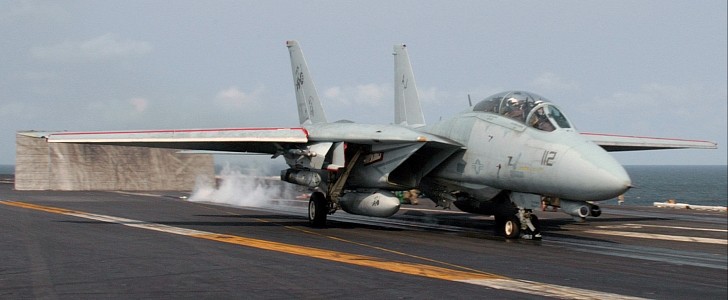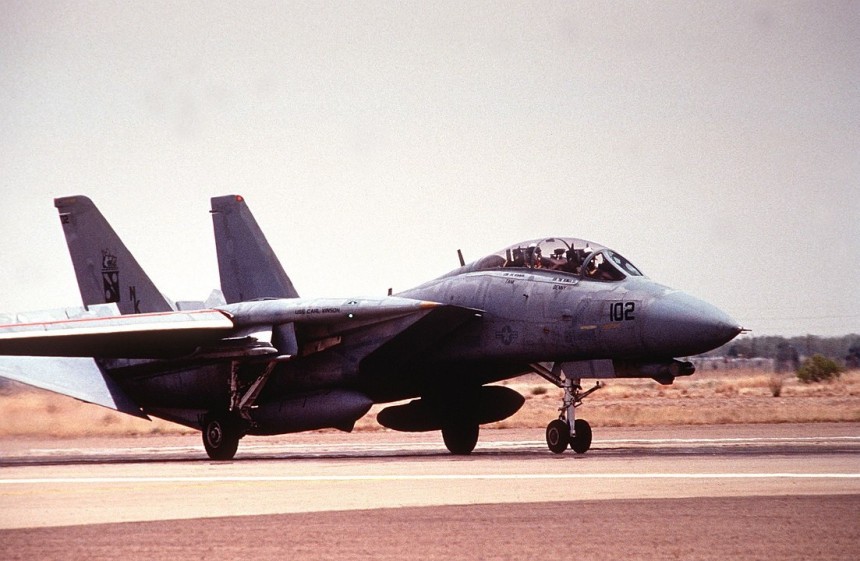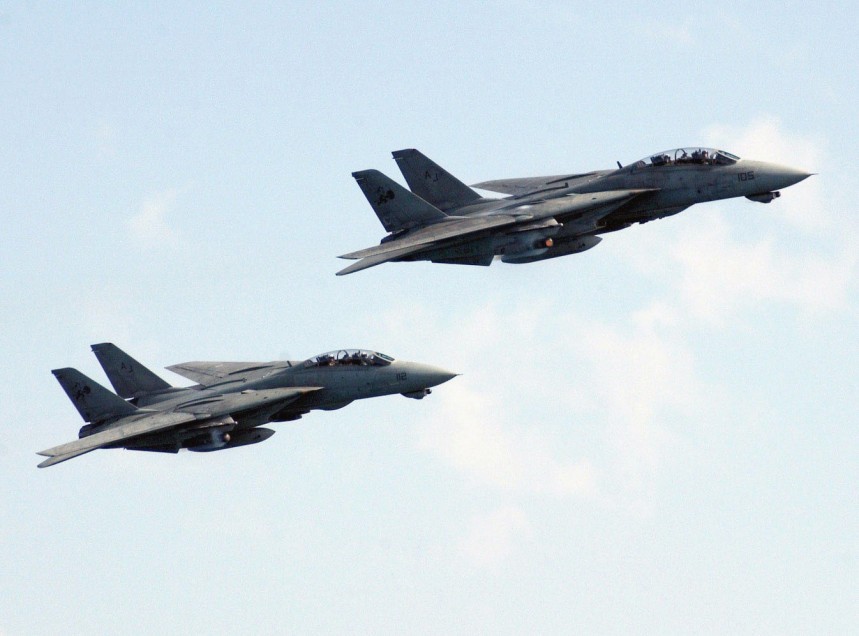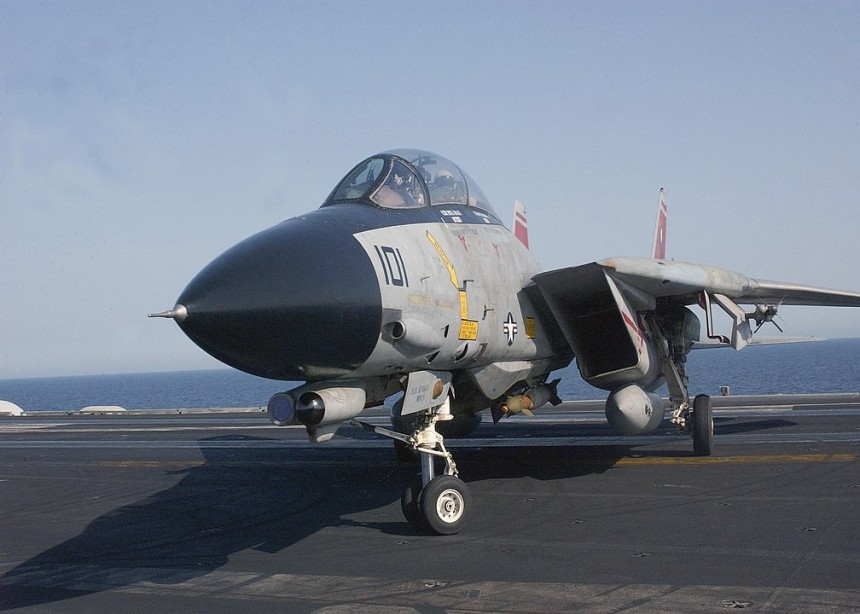Okay, so the Grumman F-14 Tomcat is one of if not the most recognizable naval fighter aircraft in history. People gush over it as if it was the biggest travesty of the 21st century when it was decommissioned back in 2006.
Quite a few theories have been floating around as to why the Tomcat bit the dust almost two decades ago. Be it due to the F-35 Joint Strike Fighter development team throwing its weight around, that's one popular theory. Alternatively, it could be because the Pentagon foolishly exported a fleet of F-14 to the Shah's Iran roughly five or so minutes before an anti-west coup put a fanatical dictator in charge.
Whatever the case may be, it's fairly well understood that the U.S. took a pretty big gamble on the F-14Ds in service at the end of careers being as antiquated as they appear to have made it out to be. Just as an exercise in LARPing as an Air Force General, let's look at some facts and figures about the F-14 and see how they measure up.
But before that, let's take a minute to tell you the story of the Tomcat from beginning to end. In abridged form, of course. We featured an entire long one about the General Dynamics-Grumman F-111B Navy fighter program. To not spoil that item too much, safe to say it was a pretty substantial flop.
General Dynamics fled from the project and ran as fast as they could in the other direction as soon as the Navy ascertained the F-111Bs own usefulness. What was leftover for Grumman to play with were the Pratt & Whitney TF30 engines, some radar and avionics equipment, and a few other items. Enough to come up with another, all-new design to compete for yet another Navy contract. The rest is pretty much history.
By 2006, the Tomcat had evolved into what would be its apex in the F-14D variant. This type featured a then state-of-the-art Hughes AN/AWG-9 all-weather Doppler radar. Capable of monitoring both air and ground threats over a broad area. It also featured the Remotely Operated Video Enhanced Receiver (ROVER) system to allow the Tomcat to see in real-time what an unmanned aerial vehicle is seeing at any given moment..
It also sported more reliable General Electric F110-GE-400 afterburning turbofan engines cranking out 16,610 lbs (73.9 kN) thrust each dry. Or as much as 28,200 lbs (125 kN) with afterburners ablaze. A huge improvement over the unreliable and thirsty engines in earlier Tomcats.
The Tomcat was designed to be much less of a pig than the 88,000 pounds fully-loaded F-111B. But even so, at 74,350 lb (33,725 kg) fully loaded, it was no featherweight either. The heaviest twin-engined Naval fighter in U.S. history, in fact. Tomcats could be loaded with everything from guided and unguided bombs to rockets and air to ground missiles.
That's without mentioning the assortment of Aim 54 Phoenix, Aim 9 Sidewinder, and Aim 7 Sparrow air to air missiles the F-14D could have carried into battle. The F-14D's sub-systems were hailed as some of the best in the world in the mid-2000s. It's even been said that the U.S. Air Force and Navy failed to make a fighter-jet radar that was superior until at least the very late prototype phases of the fifth-generation F-22 Raptor and F-35 Joint Strike Fighter, respectively.
Whether conjecture about its technology is just hyperbole is anyone's guess, unless you're an ex-Navy Tomcat pilot, we suppose. But since we don't have any of them on-call, let's compare some performance figures about the F-14D and how they fare against modern adversaries. We suppose it would be pretty obvious what the outcome would be of pitting an F-14D against a fifth-gen stealth fighter like a Raptor or a Su-57. Instead, let's use generation 4+ aircraft that the Tomcat would be more likely to see in combat anyway.
Take, for example, the Sukhoi Su-27S and Mikoyan-Gurevich MiG-29K. Two of the finest Russian Navy fighters in service today. It's clear that these respective Russian planes have a clear advantage in a visual range dogfight. The Su-27 was the first airplane to successfully perform the famed Cobra maneuver with pilot Victor Pugachev at the stick. Chinese copies of the Su-27 called the Shenyang J-11 shares these characteristics. Their built-in Phazotron Zhuk-MSE radar is also respectable and capable in its own right.
In terms of raw speed, the Tomcat keeps pace with modern Navy fighters, matching the Su-27s top speed of 2.3 times the speed of sound. So then, against non-stealth combatants, the F-14D could at least stand a fighting chance in a hypothetical scenario.
The deciding factor would ultimately come down to whether the adversary can pass the beyond visual range barrier. If that's the case, the Tomcat would be in serious trouble without a skilled enough pilot to compensate.
Weighing nearly 80,000 pounds fully loaded can only be a detriment in this case to boot. The Sukhoi and MiG don't even get close to this weight figure. Thankfully, it's an engagement that is bound to remain in our imaginations.
As the type will likely never fly again outside of Iran ever again, discussing this notion is purely an exercise in fantasy and thinly veiled fan-fiction. But, it's always fun to speculate, even so. Do you think the F-14D would have faired decently in a modern battlefield? Let us know in the comments below, and keep it civil if you'd be so kind.
Whatever the case may be, it's fairly well understood that the U.S. took a pretty big gamble on the F-14Ds in service at the end of careers being as antiquated as they appear to have made it out to be. Just as an exercise in LARPing as an Air Force General, let's look at some facts and figures about the F-14 and see how they measure up.
But before that, let's take a minute to tell you the story of the Tomcat from beginning to end. In abridged form, of course. We featured an entire long one about the General Dynamics-Grumman F-111B Navy fighter program. To not spoil that item too much, safe to say it was a pretty substantial flop.
General Dynamics fled from the project and ran as fast as they could in the other direction as soon as the Navy ascertained the F-111Bs own usefulness. What was leftover for Grumman to play with were the Pratt & Whitney TF30 engines, some radar and avionics equipment, and a few other items. Enough to come up with another, all-new design to compete for yet another Navy contract. The rest is pretty much history.
It also sported more reliable General Electric F110-GE-400 afterburning turbofan engines cranking out 16,610 lbs (73.9 kN) thrust each dry. Or as much as 28,200 lbs (125 kN) with afterburners ablaze. A huge improvement over the unreliable and thirsty engines in earlier Tomcats.
The Tomcat was designed to be much less of a pig than the 88,000 pounds fully-loaded F-111B. But even so, at 74,350 lb (33,725 kg) fully loaded, it was no featherweight either. The heaviest twin-engined Naval fighter in U.S. history, in fact. Tomcats could be loaded with everything from guided and unguided bombs to rockets and air to ground missiles.
That's without mentioning the assortment of Aim 54 Phoenix, Aim 9 Sidewinder, and Aim 7 Sparrow air to air missiles the F-14D could have carried into battle. The F-14D's sub-systems were hailed as some of the best in the world in the mid-2000s. It's even been said that the U.S. Air Force and Navy failed to make a fighter-jet radar that was superior until at least the very late prototype phases of the fifth-generation F-22 Raptor and F-35 Joint Strike Fighter, respectively.
Take, for example, the Sukhoi Su-27S and Mikoyan-Gurevich MiG-29K. Two of the finest Russian Navy fighters in service today. It's clear that these respective Russian planes have a clear advantage in a visual range dogfight. The Su-27 was the first airplane to successfully perform the famed Cobra maneuver with pilot Victor Pugachev at the stick. Chinese copies of the Su-27 called the Shenyang J-11 shares these characteristics. Their built-in Phazotron Zhuk-MSE radar is also respectable and capable in its own right.
In terms of raw speed, the Tomcat keeps pace with modern Navy fighters, matching the Su-27s top speed of 2.3 times the speed of sound. So then, against non-stealth combatants, the F-14D could at least stand a fighting chance in a hypothetical scenario.
Weighing nearly 80,000 pounds fully loaded can only be a detriment in this case to boot. The Sukhoi and MiG don't even get close to this weight figure. Thankfully, it's an engagement that is bound to remain in our imaginations.
As the type will likely never fly again outside of Iran ever again, discussing this notion is purely an exercise in fantasy and thinly veiled fan-fiction. But, it's always fun to speculate, even so. Do you think the F-14D would have faired decently in a modern battlefield? Let us know in the comments below, and keep it civil if you'd be so kind.










